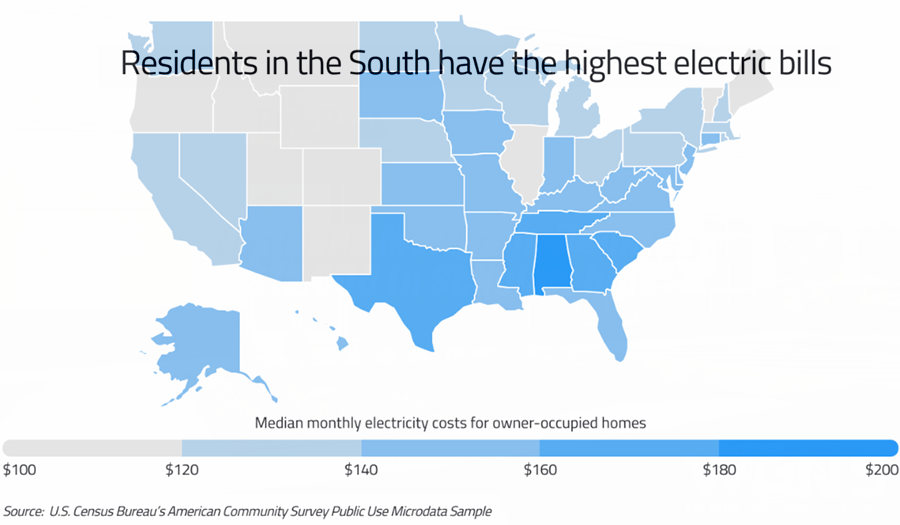Summer brings with it two certainties: rising temperatures and rising electric bills.
Locally, electricity accounts for about 70% of utility bill costs in Tennessee, while the remaining percentage covers water, gas or other utility related sources. Once the bills are added up, residents in places like Rutherford County and across the Volunteer State are at number 6 on the list for having the 6th highest expense in utilities.
When examining the past year, renters and homeowners spent more time in their residences amid pandemic closures and companies shifting to work-from-home models. Homes and apartments that were previously dormant during work hours were suddenly filled with people working and kids attending online school. Amid this new reality, heat waves blanketed the country, causing a spike in energy use as Americans tried to keep their homes cool. Energy bills shot up and, for some, the higher bills were simply too expensive. Lawmakers did their best to curb the crisis by implementing moratoriums on utility shut-offs.
These heat waves weren’t an aberration, according to the Environmental Defense Fund. In fact, the number of deadly heat waves that swept the nation tripled from the 1960s to the 2010s, and they’re expected to continue.
For the average electricity customer, that means that rates are likely to rise as demand rises, and bills are bound to go up. According to the Census Bureau, electricity already accounts for nearly 60% of residential utility bills and more than 12% of total housing costs for owner-occupied households. And if the past two decades are any indication—rates have increased 70%—the future looks to be an expensive one.
While the data is clear that electricity prices are on the rise, some states are feeling the increase far more than others. Hawaiians paid the highest rates at an average of 30.32 cents per kWh in 2020, which is more than 30% higher than Alaskans, whose electricity rates are the second most expensive in the nation. The next three states with the highest rates are in New England—Connecticut, Massachusetts, and Rhode Island. Conversely, Oklahoma, Washington and Louisiana are the only three states in the country with residential electricity rates below 10 cents per kWh.
Knowing a state’s energy prices is just part of understanding the economics of electricity for its residents. A state with expensive electricity rates doesn’t necessarily have the highest median electricity bills, which are a function of both energy prices and consumption. For example, Hawaii’s electricity costs more than any other state, but the median electric bill of $140 ranks 26th.
According to data from the Census Bureau, residents in the South report the highest median electricity bills, with Alabama residents topping the list at $200 per month. Alabamans are paying not just more than any other state on a monthly basis, but their electricity bills make up 75.5% of their utility bill and 26.6% of their housing costs, both the highest in the nation. Other states with median electricity bills topping $160 per month include Texas, South Carolina, Georgia, Mississippi, and Tennessee.
To determine the states with the largest electric bills, researchers at Commodity.com analyzed Census Bureau data and calculated the median monthly electricity costs for owner-occupied, non-farm households. This data represents what residents pay in total for electricity on a monthly basis—a function of both electricity rates and electricity use. In the event of a tie, the location with the higher median total utility costs—including gas, water, and other fuels—was ranked higher. Researchers also calculated median total housing costs, as well as the proportion of total housing and utility costs that electric bills account for.
The analysis found that at a median $160 per month, electricity costs in Tennessee account for 70.6% of total utility costs and 18.7% of total housing costs. Out of all states, Tennessee has the 6th highest electric bills.
Here is a summary of the data for Tennessee:
Median monthly electricity costs: $160
Median total utility costs: $227
Median total housing costs: $854
Electricity as a share of total utility costs: 70.6%
Electricity as a share of total housing costs: 18.7%
For reference, here are the statistics for the entire United States:
Median monthly electricity costs: $140
Median total utility costs: $238
Median total housing costs: $1,120
Electricity as a share of total utility costs: 58.7%
Electricity as a share of total housing costs: 12.5%
For more information, a detailed methodology, and complete results, you can find the original report on Commodity.com’s website: https://commodity.com/blog/
Listen to WGNS "LIVE" by downloading the iTunes or Google Play app for free.





